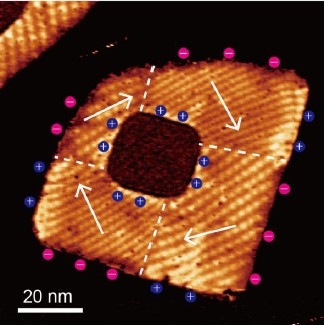Physicists Create Polarization Vortices in a Two-Dimensional Material

Scanning tunneling microscope topographic image of a SnTe/PbTe monolayer lateral heterostructure. The paraelectric PbTe monolayer core (dark) is surrounded by a ferroelectric SnTe monolayer, which develops a clockwise polarization vortex within its domains.
A U of A research team, in conjunction with researchers at the Max Planck Institute of Microstructure Physics and Beijing Academy of Quantum Information Sciences, has discovered polarization vortices in two-dimensional (2D) ferroelectrics.
U of A physics postdoctoral research associate John W. Villanova led the theory contribution to the paper which was recently published in Advanced Materials.
Experiments were performed at the Max Planck Institute of Microstucture Physics. SnTe/PbTe monolayer lateral heterostructures were produced via molecular beam epitaxial growth, and scanning tunneling microscopy measurements show an atomically sharp interface between the ferroelectric and paraelectric domains. By carefully measuring the electronic band-bending at the edges of the SnTe monolayer, the polarization orientation was deduced to orient in a vortex consisting of four quadrants around the PbTe monolayer core, always with a component which points toward the core. The density functional theory calculations performed at the U of A contextualized the measurements in terms of relative work functions and charge transfer, consistent with the positive bound charge at the SnTe/PbTe monoayer interface. This engineering of the polarization state in novel 2D lateral heterostructures with in-plane polarization has an eye toward applications.
Besides Villanova, the list of authors includes U of A associate professor of physics Salvador Barraza-Lopez; Kai Chang of Beijing Academy of Quantum Information Sciences; and Jing-Rong Ji, Felix Küster, Paolo Sessi and professor Stuart S.P. Parkin of the Max Planck Institute of Microstructure Physics.
Work at Arkansas was funded by an Early Career Grant from the U.S. Department of Energy, Office of Basic Energy Sciences (Award DE-SC0016139). Calculations were performed at U of A's Trestles, funded by the U.S. National Science Foundation (Grants 0722625, 0959124, 0963249 and 0918970), a grant from the Arkansas Economic Development Commission and the U of A Division of Research and Innovation, and at Cori at NERSC, under Contract No. DE-AC02-05CH11231.
Topics
Contacts
John W. Villanova, postdoctoral research associate
Department of Physics
479-575-5555,
jvillano@uark.edu
Headlines
Four Students Named Goldwater Scholars; Two Earn Udall Honorable Mentions
Four U of A students have received the prestigious Goldwater Scholarship, an award for top students in mathematics, science, and engineering.
Cross-Campus Collaboration Culminates in New Outdoor Geological Installation
Grand opening event to celebrate the new GeoLab installation at the U of A’s Gearhart Hall courtyard is set for May 3. The installation will be open to the public year-round.
First Students to Use Online Degree to Hone Nursing Leadership, Elevate Patient Care
Hanna Baxendale and Wendi Kimbrell will begin coursework in the Doctor of Nursing Practice-Executive Master of Business Administration program offered by the Eleanor Mann School of Nursing and Walton College.
Join the Office for Sustainability on a Final Cruise to Campus
Cruise to Campus Wednesdays have fostered a gathering space for individuals interested in biking to campus. Drop by the Old Main Lawn from 7:30-10 a.m. Wednesday for coffee, something to eat and conversation.
Fay Jones School Student Ambassador Program Gives Voice to Design Students
The student ambassador program at the Fay Jones School of Architecture and Design is built to connect top design students with their school, its alumni, its future students and others inside and outside the school.




